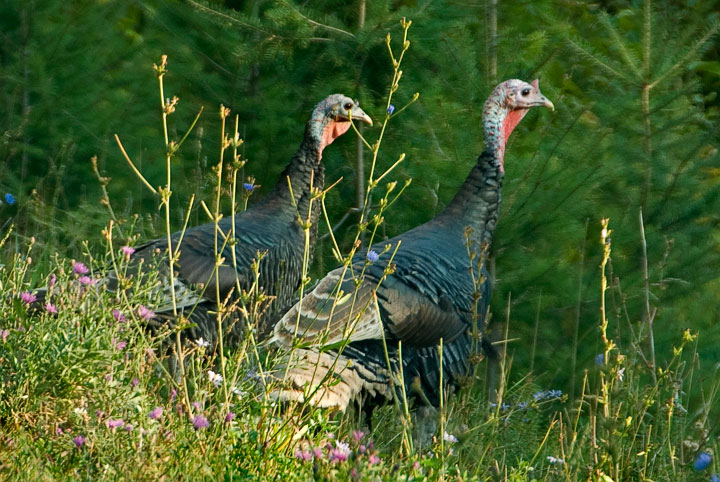Turkeys
When I first encountered wild turkeys around Kootenay Lake, I did a double take—wild turkeys, you have to be kidding! Yet, there they were. Mind you, they are not native. Wild turkeys had been introduced into Washington State and some emigrated. By the late 1960s, they had reached the south end of the Main Lake, likely via Idaho, and were seen around Salmo, Trail, and Nelson. Gradually they spread elsewhere around the Lake, where, as far as I can tell, most people merely treat them as curiosities.
In British Columbia, Wild Turkeys are largely confined to the Kootenays (there are a few in the Okanagan). Wild turkeys are now reported around the whole Lake, except possibly where the lakeshore is precipitous. Further, they are found south of the Lake to the border, north of the Lake to Meadow Creek, and down the Kootenay River beyond Castlegar. In short turkeys are here.
 Wild Turkey portrait: nearly featherless head, with red and bluish skin; a snood, the fleshy growth an the forehead; caruncles, red fleshy lumps on the head and neck; dewlap, red webbing below the chin.
Wild Turkey portrait: nearly featherless head, with red and bluish skin; a snood, the fleshy growth an the forehead; caruncles, red fleshy lumps on the head and neck; dewlap, red webbing below the chin.
It is February; soon this male will begin courting. Blood will rush to its head, the snood will elongate and hang down over the beak, and the wattle will turn a bright red. Hens prefer to mate with a gobbler with a big snood.
For a comparison between the male and female heads, see the pair of images just below.
 The female Wild Turkey (hen) is distinguishable from the male by having a smaller snood (fleshy projection between the eyes and beak) and more feathers on the crown of the head. Both have a dewlap (red webbing under chin) and caruncles (fleshy red growths on head and neck).
The female Wild Turkey (hen) is distinguishable from the male by having a smaller snood (fleshy projection between the eyes and beak) and more feathers on the crown of the head. Both have a dewlap (red webbing under chin) and caruncles (fleshy red growths on head and neck).
 The male Wild Turkey (gobbler) is distinguishable from the female by having a larger snood (fleshy projection between the eyes and beak) and having a nearly bald crown. Both have a dewlap (red webbing under chin) and caruncles (fleshy red growths on head and neck).
The male Wild Turkey (gobbler) is distinguishable from the female by having a larger snood (fleshy projection between the eyes and beak) and having a nearly bald crown. Both have a dewlap (red webbing under chin) and caruncles (fleshy red growths on head and neck).
 The subspecies found around the Lake (and throughout the Kootenays) is the Merriam’s Wild Turkey. Adult males are clearly distinguished from subspecies at most other places on the continent by the nearly white feathers on the lower back and by white tail feather margins.
The subspecies found around the Lake (and throughout the Kootenays) is the Merriam’s Wild Turkey. Adult males are clearly distinguished from subspecies at most other places on the continent by the nearly white feathers on the lower back and by white tail feather margins.
 The turkey is a social bird. This is a portion of a flock of about twenty.
The turkey is a social bird. This is a portion of a flock of about twenty.
 A pair of wild turkeys moves through the woods in the late spring.
A pair of wild turkeys moves through the woods in the late spring.
 This female wild turkey wanders the lawns and beaches along Crescent Bay.
This female wild turkey wanders the lawns and beaches along Crescent Bay.
 It even wanders out onto docks apparently to get closer to the ducks.
It even wanders out onto docks apparently to get closer to the ducks.
 Although it watches the ducks intently, the ducks take no interest in it.
Although it watches the ducks intently, the ducks take no interest in it.
 Two adults head down a steep bank into the woods.
Two adults head down a steep bank into the woods.
 Two turkey chicks strain to keep up with mother.
Two turkey chicks strain to keep up with mother.
 The mottled plumage of the turkey chicks provides a good camouflage in the grass. It is easy to miss them at first glance.
The mottled plumage of the turkey chicks provides a good camouflage in the grass. It is easy to miss them at first glance.
Information from Wikipedia: Wild Turkey.
![]()